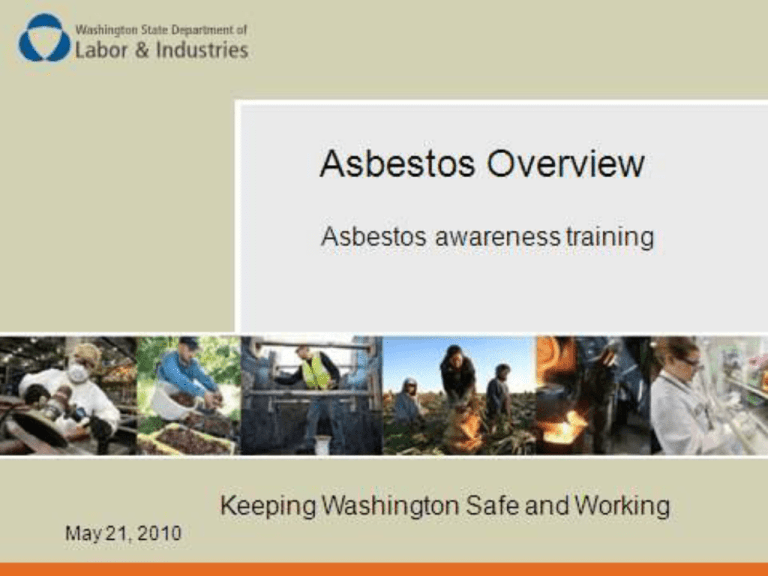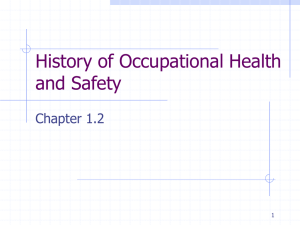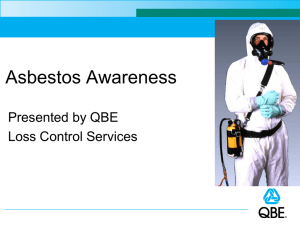AsbestosAwarenessMay2010 - Washington State Healthcare
advertisement

Course Outline The following topics will be covered: Types & properties of asbestos Uses of asbestos Health effects of asbestos General asbestos rule requirements What is Asbestos? Serpentine Rock (Chrysotile) - California State Rock Close-up of Asbestos Fibers Common Types of Asbestos Chrysotile – most common “White Asbestos” Amosite “Brown Asbestos” Crocidolite – least used “Blue Asbestos” Chrysotile asbestos mine in Canada Other types of asbestos Tremolite (Libby vermiculite mine-actually winchite-richterite) Actinolite Anthophyllite Vermiculite Vermiculite ore “Popped” Vermiculite Vermiculite insulation in attics Libby Vermiculite Mine Photo of operating Libby mine Zonolite insulation Libby Mine site today Uses of Asbestos Asbestos = “inextinguishable” Egyptians; Greeks & Romans Middle Ages Industrial Revolution Twentieth century – *World War II + next 30 years Properties of Asbestos Naturally occurring fibrous minerals Good tensile strength Flexibility Heat resistance Asbestos ore Electrical resistance Good insulation Chemical resistance Some Asbestos-Containing Materials* (This list does not include every product/material that may contain asbestos. It is intended as a general guide to show which types of materials may contain asbestos.) • • • • • • • • • • • • Cement Pipes Cement Wallboard Cement Siding Asphalt Floor Tile Vinyl Floor Tile Vinyl Sheet Flooring Flooring Backing Construction Mastics (floor tile, carpet, ceiling tile, etc.) Acoustical Plaster Decorative Plaster Textured Paints/Coatings Ceiling Tiles and Lay-in Panels • • • • • • • • • • Spray-Applied Insulation Blown-in Insulation Fireproofing Materials Taping Compounds (thermal) Packing Materials (for wall/floor penetrations) High Temperature Gaskets Laboratory Hoods/Table Tops Laboratory Gloves Fire Blankets Fire Curtains * Source: EPA Some Asbestos-Containing Materials (Continued) • • • • • • • • • • • • Elevator Equipment Panels Elevator Brake Shoes HVAC Duct Insulation Boiler Insulation Breaching Insulation Ductwork Flexible Fabric Connections Cooling Towers Pipe Insulation (corrugated air-cell, block, etc.) Heating and Electrical Ducts Electrical Panel Partitions Electrical Cloth Electric Wiring Insulation • • • • • • • • • • • • Chalkboards Roofing Shingles Roofing Felt Base Flashing Thermal Paper Products Fire Doors Caulking/Putties Adhesives Wallboard Joint Compounds Vinyl Wall Coverings Spackling Compounds Asbestos is an Inhalation Hazard Airborne asbestos fibers inhaled deep into the lung can cause damage. Respirable fibers are inhaled and deposited in the lungs Body’s defense mechanisms cannot break down the fibers Fibers cause damage to respiratory system Damage occurs in the alveoli Asbestos-related diseases Asbestos can cause disabling respiratory disease and various types of cancers if the fibers are inhaled. - Asbestosis - Lung Cancer - Mesothelioma - Other cancers Smoking and Asbestos Risk Multiplier Lung Cancer Risks 50 45 40 35 30 25 20 15 10 5 0 No Exposure 70 per 100,000 lung cancer deaths in general population Asbestos 5x higher risk than general population Smoking 10x higher risk Asbestos + Smoking 50x to 90x higher risk Asbestosis Example Photos ©RAVANESI@2000 Joe Darabant, 1949. Joe, 1989. Covered with chrysotile asbestos fibers. Worked for 30+ years at the Johns-Manville Plant in New Jersey, cutting asbestos shingles and making asbestos block and pipecovering materials. Forced to retire in 1974 at age 50 from poor health; he died from asbestosis in 1990 at age 66. Current worker exposure to asbestos An estimated 1.3 million workers are exposed in U.S. today. In the construction industry, removal renovation and demolition have heaviest exposures. In general industry, exposure can occur in: manufacture of asbestos products automotive brake and clutch repair housekeeping and custodial work Some Washington State Statistics 3716 L & I asbestosis claims filed in the last 20 years (1988 – 2007) 558 deaths in Washington from mesothelioma in 1999-2005 (CDC data) Mesothelioma deaths – 1979-2001 DOSH Citations in 2006-2008 - 362 inspections resulting in 935 violations - 73% of these violations were cited serious - $780,350 in penalties assessed. Where could you be exposed to asbestos? Asbestos had a variety of uses in building construction completed before 1981. You could be exposed to asbestos during inspection of the following activities in these older buildings: Asbestos removal projects Building insulation maintenance or repair Heating and air conditioning maintenance and repair Insulated piping maintenance repair Floor tile or flooring replacement or repair Roofing or siding replacement or repair Non-metal piping replacement or repair (cement-asbestos piping) Brake shoe or pad replacement or repair Wallboard(sheetrock) or wall plaster replacement or repair “Popcorn ceiling” replacement or repair Janitorial or maintenance work done in pre-1981 buildings Building demolition Brief history of U.S. asbestos regulation British physicians noted that asbestos workers developed lung disease in early 1900’s. Lung disease noted in American asbestos workers in 1930’s. Some companies actively suppressed this information. Dr. Irving Selikoff at Mt. Sinai Hospital in New York began studying asbestos workers in 1960’s. His published research led OSHA to adopt specific standard on asbestos in early 1970’s. OSHA lowered the PEL for asbestos several times through 1970’s, 1980’s and 1990’s. Dr. Selikoff also warned against hazards to workers who were spraying on asbestos insulation in the World Trade Center. Thermal System Insulation (TSI) Asbestos insulation on outdoor pipe Air cell pipes Damaged insulation on control valve Thermal system insulation close-up Asbestos air cell insulation (pipe insulation) Visible asbestos fibers “Mag” Pipe Insulation Asbestos Duct Tape More Thermal System Insulation Asbestos insulated boiler Asbestos insulated furnace Asbestos gaskets, rope and packing – may be round, flat or impregnated with waterproof sealant Asbestos rope Damaged asbestos gasket Asbestos fabric in HVAC system Asbestos Ceiling Tile Tile close-up Usually in 1’ by 1’ or 2’ by 4’ sizes Asbestos shingle siding Asbestos Roofing Material Nicolite asbestos roofing felt over skip sheeting Nicolite roofing debris Popcorn overspray in electrical junction box Knob and Tube asbestos wiring Asbestos wiring (knob and tube) Vinyl asbestos and asphalt asbestos flooring Asbestos Sheet Vinyl Uncontrolled sheet vinyl removal Surfacing Material Sprayed-on surfacing material Acoustical material Spray-on insulation containing asbestos Asbestos fireproofing in ceiling and above dropped ceiling Popcorn-orange peel-knock down Surfacing Material Dry popcorn ceiling removal Popcorn Ceiling Material ### Uncontrolled popcorn ceiling removal job damaged and friable popcorn ceiling material Fire-damaged popcorn ceiling material Ceiling showing damage Popcorn ceiling material dropped onto furniture Chimney flue packing (mud) containing asbestos Asbestos Mill Board Glue/Mastic buttons or dots-ceiling tile, chalk boards, cove base mastic Cement-asbestos pipe (Transite) Buried cement asbestos pipe in Tri-cities area Asbestos Window Putty Asbestos Brake Pads & Discs Asbestos in joint compound and plaster Asbestos in electrical panel Rock Wool Insulation – for comparison How do asbestos fibers get in the air? Asbestos is most hazardous when it is FRIABLE. Physical disturbance of asbestos-containing materials (ACM) suspends fibers in the air. Friable: can be easily crumbled or crushed by hand, releasing fibers into the air Very small fibers stay in the air for long periods Damaged or deteriorated ACM increases friability How do asbestos fibers get in the air? Some typical activities and situations that can result in asbestos exposure: Mechanical action on ACM (cutting, sawing, grinding, sanding, drilling, buffing, etc.) Disturbing/breaking ceiling tiles Removing/replacing insulation Disturbing sprayed-on asbestos Asbestos abatement projects Debris from disturbance of “popcorn” ceiling Un-surveyed construction projects on older buildings DOSH Asbestos Regulations RCW 49.26 Asbestos Safety Act WAC 296-62-077 Part I-1 Occupational Health-Asbestos WAC 296-65 Asbestos Certification & Training WAC 296-155-160 Construction regulations which refer to WAC 296-62-077 EPA Asbestos Environmental Regulations AHERA (Asbestos Hazard Emergency Response Act ) NESHAP National Emission Standards for Hazardous Air Pollutants) Regulatory Agencies enforcing NESHAP – Department of Ecology – Local Air Pollution Authorities – Washington State Department of Health & county health departments Building/Facility Owners Responsibilities Determine presence, location, and quantity of any ACM/PACM Inform affected contractors, employees and tenants Have “Good Faith” Inspection done before any construction/maintenance work or project bidding Allow only certified individuals to perform work Submit Notice of Asbestos Abatement Project to L&I at least ten days before work begins “ACM” and “PACM” Asbestos Containing Material Any material containing more than 1% asbestos by weight. Presumed Asbestos Containing Material Surfacing materials Installed prior to 1981 Thermal System Insulation Flooring Must be handled as ACM unless proved otherwise "Good Faith" Inspection (Survey) Required for all construction and maintenance: must be done by an EPA-accredited AHERA building inspector documented written report not required if assumed and treated as ACM Minimum fines of $250 per day if not done Both building owner and contractor can be cited! Employee exposure evaluation and monitoring Permissible Exposure Limits (PEL) 0.1 fibers per cubic centimeter of air (0.1 f/cc) 8-hour time weighted average (TWA8) 1.0 f/cc 30-minute short-term exposure limit (STEL) Certified Asbestos Worker (CAW) 32 hours of initial training Pass 100 question test 8 hour annual refresher training Required for Class I asbestos work Can do Class II asbestos work, but not required Certified Asbestos Supervisor (CAS) 40 hours of initial training Pass 100 question test 1,600 hours of experience required 8 hour annual refresher training Required for Class I, II and III asbestos work Subject to denial, suspension and revocation of certification Certified Asbestos Abatement Contractor Must have one or more Certified Asbestos Supervisor Must be a Washington licensed contractor Renewed annually Subject to denial, suspension and revocation of certification Four Classes of Asbestos Work Class I - removal of thermal system insulation and surfacing ACM/PACM Class II - removal of ACM which is not thermal system insulation and surfacing material Class III - Repair & maintenance operations where ACM is disturbed Class IV - Maintenance & custodial activities during which ACM is contacted, but not disturbed Class 1 Asbestos Abatement • Requires Negative Pressure Enclosure (NPE) (Glove bags for pipe runs) • Requires 3 stage decontamination • Requires separate waste load out • Requires Certified Asbestos Supervisor • Requires Certified Asbestos Workers • Requires L & I Notification if > 48 sq. ft. • Supplied air respiratory protection • Requires air monitoring • Initial monitoring • Daily monitoring • Clearance monitoring Communication of Hazards Warning Signs for regulated areas visible before entering Warning Labels attached to all products and their containers AVOID BREATHING AIRBORNE ASBESTOS FIBERS Exposure Control Program Asbestos exposure must be controlled by one or more of the following engineering and work practices: Local exhaust ventilation with HEPA filter system HEPA-filtered vacuums Enclosure, isolation Wet methods Intact handling Clean-up, prompt disposal Housekeeping HEPA filter = high efficiency particulate air filter Exposure Control Program Worker protection Personal protective Equipment (PPE) Hygiene facilities Decontamination shower respirator, gloves, head protection, foot protection, coveralls washing, decontamination, change room Class II Asbestos Work • • • • • Requires critical barriers not NPE Requires intact, non-mechanical removal Requires wet methods Requires Certified Asbestos Supervisor Does not require Certified Asbestos Workers • 8 hours of specific training • Does not requires L & I Notification • Air purifying respirators allowed (HEPA) • Requires air monitoring • Initial monitoring • Daily monitoring • Clearance monitoring Specific requirements for other work Automotive brake and clutch work Roofing, flooring, siding and gaskets Class III Asbestos Work Requires wet methods Requires local exhaust ventilation if feasible Must isolate the operation Requires a Certified Asbestos Supervisor Does not require Certified Asbestos Workers – 16 hour of worker training required – Annual refresher training required L & I notification not required Air monitoring required Class IV Asbestos Work Contact but not disturb ACM / PACM Asbestos awareness training required – 2 hours initial – Annual refresher required No air monitoring required No Certified Asbestos Supervisor required Custodial/Light maintenance work Housekeeping and building maintenance activities may expose workers to asbestos fibers if ACM/PACM is disturbed. Activities: sweeping vacuuming cleaning changing lights Damaged asbestos pipe insulation Some materials of concern: vinyl asbestos tile exposed piping exposed fireproofing popcorn ceiling Asbestos debris on floor Custodial/Light maintenance work Dry dust or sweep surfaces, ceilings, walls, or floors Disturb ACM when replacing light bulbs, etc. DO NOT: Pin or hang pictures, plants, or objects on walls or from ceilings covered with asbestos materials Sand asbestos floor tiles or backing material Custodial/Light maintenance work DO: Dust with a damp cloth Use only a HEPA-filtered vacuum to clean up asbestos debris Wet mop floors Medical Surveillance Program Medical evaluations for all workers who are: exposed to asbestos concentrations at or above PEL performing certified asbestos work 30 or more days per year Annual examinations at no cost to worker Records maintained duration of employment + 30 years General Contractors “Asbestos Abatement Projects” may be subcontracted to a certified abatement contractor. Regulation requirements for general contractors Get good faith inspection from owner Pass asbestos information to subs Notify owner of new materials discovered Ensure proper certification of subs and workers Asbestos Certification - Contractors Contractors must be certified when they conduct “Asbestos Abatement Projects” (asbestos removal or encapsulation) in the following conditions: A potential of fiber release More than 3 square feet, or More than 3 linear feet Construction/Maintenance Activities Engineering controls, work practices Local exhaust ventilation with HEPA filter system Prohibited practices HEPA-filtered vacuums sawing without HEPA filtering Enclosure, isolation compressed air Wet methods dry sweeping/cleanup Intact handling Clean-up, prompt disposal Housekeeping Construction/Maintenance Activities Worker Protection Personal protective Equipment (PPE) – respirator, gloves, head protection, foot protection, coveralls – training on proper use Hygiene facilities – washing, decontamination, change room What is a “Competent person”? Supervisors “Asbestos Abatement Projects” Other Class I, II, and III work > 3 feet Class I: surfacing materials and thermal system insulation Class II: other asbestos materials Class III: repair and maintenance Person trained in operations and maintenance for < 3 feet (EPA criteria) Uncertified Asbestos Work Allowed Activities Class II or III work with intact materials Class IV work (contact but not disturb) Unclassified work Examples: Vinyl Asbestos Tile (VAT) Asphaltic roofing Installing asbestos containing materials Uncertified Asbestos Work (cont) Supervisor Training CAS for Class II or III (> 3 feet) Worker training for small jobs Worker Training Class II--8 hour material specific training Class III--16 hour O&M training Class IV--2 hour asbestos awareness Uncertified Asbestos Work (cont) PPE and hygiene facilities Work Practices Wet methods Intact removal HEPA filtered vacuums Prompt cleanup and disposal Specific requirements for roofing, flooring, siding and gaskets (WAC 296-62-07712) Uncertified Asbestos Work (cont) Prohibitions Sawing, chipping, grinding, etc. Compressed air Dry sweeping or shoveling Employee rotation Summary Property owner or owners agent must do an asbestos “Good Faith” inspection (AHERA) No requirement to remove intact ACM Anyone who may encounter ACM needs a minimum of Asbestos Awareness training Damaged, deteriorated or disturbed ACM must be abated Asbestos abatement normally requires an asbestos abatement contractor Warning labels may be required Further Information DOSH – asbestos webpage OSHA – asbestos webpage Environmental Protection Agency – asbestos webpage Department of Ecology – asbestos waste webpage Questions? Dave Johnson 360-902-5514 joda235@lni.wa.gov








